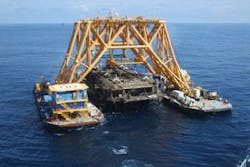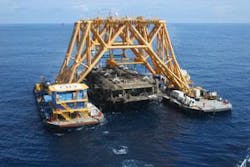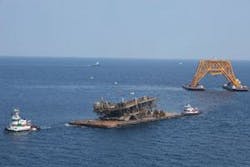SPECIAL REPORT: Heavy-lift system retrieves hurricane-damaged topsides
To date the heavy-lift system, deployed for the first time in June 2007, has recovered six hurricane-toppled platform topsides from the Gulf of Mexico and is contracted to retrieve several more.
Versabuild, an affiliate of Versabar Inc., designed, built and operates the lift system called “Bottom Feeder.”
Versabuild says each of the eight-leg topsides retrieved to date was in a single lift with peak lift weights of up to 1,600 tons. The decks were then set on cargo barges and scrapped ashore. This approach compared to small-piece removal, results in reduced personnel exposure offshore and is extremely cost-effective, according to Versabuild.
Figs. 1 and 2 show two of the recovered topsides.
Hurricane damage
The recent Ivan, Katrina, and Rita hurricanes in the Gulf of Mexico caused considerable structural damage to a number of shelf platforms. In some cases, the platforms suffered near total collapse with the topsides decks coming to rest as a single piece on the seabed adjacent to the platform substructure.
Regulatory guidelines provide several options for these topsides. One option is to reef the topsides in-place; however, Versabuild says many operators are planning to recovery from the seabed and remove the storm damaged topsides to shore.
Retrieval process
Versabuild describes the retrieval steps with its heavy-lift system as:
- Prepare each deck of the topsides for lift prior to the arrival of the lift system.
- Install prefabricated rigging assemblies and lower them to the deck structure. These are tied into the main truss row frames. Six to eight are required to complete a single deck recovery.
- With the lift system on location, set the eight-point mooring and position the system above the deck to be recovered.
- Lower the four lift blocks and deck rigging into the water with assistance from a remotely operated vehicle (ROV).
- Commence lift after confirming the state of all hook assemblies.
- Lift deck to the surface and lower it onto an awaiting, armored, cargo barge for transportation to shore and subsequent disposal.
- Capture any hydrocarbons or liquids flowing from the deck during the lifting process between the two system barges with a boom, allowing for removal and containment prior to bringing the cargo barge into the lift system. Also the armored deck barges have pollution containment and recovery systems to permit any potential hydrocarbon tainted liquids to be stored prior to the tow to shore.
Versabuild said the hookup assisted with the ROV assist takes about 4 hr and the lift itself 1-1½ hr.
It notes that recovery of the first four decks was completed during 21 days and durations from commencing the initial hookup to deck to the cargo barge leaving the site with the recovered deck on board was less than 12 hr.
The next two decks were recovered during 10 day in September with a similar time from hookup to sail away, Versabuild says.
Lift system
The lift system has two rigid space-frame truss structures spanning from hinged supports on the center lines of two regular deck transport barges, 250 ft by 72 ft in size. Versabuild says the pattern of support hinges decouples the heave, pitch, and roll motions of the support barges from the lift structures.
It says the structural design allows the system to remain stable under transit and lifting conditions and dynamic loads generated from wave action that can be expected when lifting structures both under water and through the water surface.
Versabuild validated the system in a series of scale model tests at the offshore model basin in Escondido, Calif.
This system is designed to lift structures as single units from the seabed in water depths up to 400 ft. The system has a rated lifting capacity of 4,000 tons. Versabuild notes that the four independent lift blocks allow for controlled lift operations of the large unbalanced structures for which accurate weight data are unavailable. These structures may rest on the seabed at varying degrees out-of-level and in some instances may be upside down.
Each lift block has a 1,000-ton rated lift capacity and the blocks have a 45 ft by 80 ft spacing for flexibility to distribute lift loads and accommodate an out of level structure with an unknown lift weight and center of gravity.
The blocks operate in synchronous mode or independently.
Versabuild notes that the 3D space frame of the structure also provides out-of-plane or side-load capacity, allowing for structures that initially lift out of level to be lifted and releveled during the lifting process without the need to rerig. It adds that the pattern of support hinges also dampens the effect of skewed-loading, reducing the possibility of overloading one lift point during lifting operations.
The clearance between the support barges is about 110 ft at the water line, which allows a 400 ft by 100 ft barge, which hauls away the topsides, to be maneuvered between the support barges.


